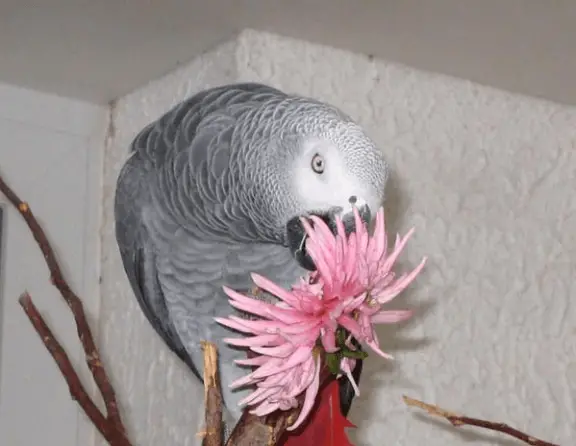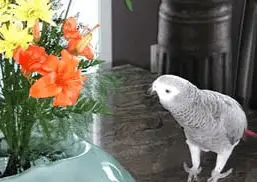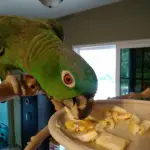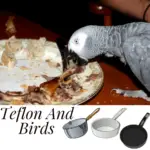
Safe plants for parrots: These plants are considered safe for your parrot until exposed or treated with an insecticide, pesticide, or fungicide. At this point, they become very toxic to your bird.
Safe plants for parrots:
| French name | Latin name |
| abelia abelia | abelia |
| garlic | allium savitum |
| aloe vera X | aloe |
| pineapple | ananas comosus |
| fragrant dill | anethum graveolens |
| aralia / udo | aralia |
| arbutus | arbutus unedo |
| bottle tree | beaucarnea recurvata |
| jade tree | crassula ovata |
| arctotis | arctotis stoechadifolia |
| aspidistra | aspidistra |
| hawthorn | crataegus |
| bamboo | * all (pseudosasa, phyllostachys …) |
| begonia | begonia |
| bougainvillea | bougainvillea |
| birch | betula |
| bromeliad | bromeliad balansae |
| easter cactus | rhipsalidopsis |
| coffee tree | coffea arabica |
| calamity | calamintha |
| camellia | camellia |
| Roman chamomile | chamaemelum nobile |
| capillary, Venus hair | adianthum |
| nasturtium | tropaeolum majus |
| carob tree | ceratonia siliqua |
| cornflower knapweed | centaurea cyanus |
| ceraiste | cerastium |
| thistle or wild cirse | cirsium arvense |
| honeysuckle | lonicera |
| wild chicory | cichorium intybus |
| variegated croton | codiaeum variegatum |
| dahlia | dahlia |
| echeveria | echeveria |
| endive / chicory | cichorium |
| Rio ephemeral | tradescantia fluminensis |
| spruce / spruce / pesse | picea |
| barberry | berberis vulgaris |
| eugenia | eugenia |
| faux beech | nothofagus |
| zucchini flowers | cucurbita pepo |
| boston fern | nephrolepsis bostoniensis |
| bird’s nest fern | asplenium nidus |
| ash | fraxinus |
| gardenia | gardenai jasminoides |
| gloxinia | sinningia speciosa |
| purple gynura | gynura aurantiaca |
| gypsophila / baby’s breath | gypsophilia paniculata |
| daylily | hemerocallis |
| beech | fagus |
| california holly | heteromeles arbutifolia |
| hoya | hoya carnosa variegata |
| hibiscus | hibiscus |
| impatient or balsam | impatiens |
| iresine | iresine herbstii |
| star jasmine | trachelospermum jasminoides |
| houseleek | sempervivum |
| kalanchoe | kalanchoe |
| angels tears | helxine soleirolii |
| Swedish ivy | plectranthus australis |
| common lilac | syringa vulgaris |
| lucky bamboo | dracaena braunii or sanderiana |
| butterfly lily | calochortus nuttallii |
| wild ginger | hedychium coronarium |
| lysimachus | lysimachia |
| magnolia | magnolia |
| manzanita | arctostapylos manzanita |
| arrowroot | maranta leuconeura |
| larch | larix |
| melic | melica |
| lemon balm | melissa officinalis |
| pepper mint | mentha x piperita |
| green mint | mentha spicata |
| chickweed | stellaria media |
| nandina | nandina domestica |
| hazel | corylus avellana |
| marigold / marigolds | tagetes |
| bohemian olive tree | elaeagnus augustifolia |
| elm | ulmus |
| Morgane stonecrop | sedum morganianum |
| multiply palm kernel | areca lutescens |
| date palm | phoenix dactylifera |
| blue passion flower | Passiflora caerulea |
| peperomia | peperomia |
| parsley | petroselinum |
| petunia or St-Joseph | petunia |
| poplar | populus |
| norfolk pine | araucaria exelsa |
| dandelion | taraxacum officinalis |
| aluminum plant | pilea cadioerei |
| spider plant | chlorophytum comosum |
| wrought iron plant | aspidistra |
| fireworks plant | pilea microphylla |
| sensitive plant / modest mimosa | mimosa pudica |
| Ti plant | cordyline terminalis |
| zebra plant | aphelandra squarrosa |
| Apple tree | penalty |
| Natal plum | carissa macrocarpa |
| raphiolepid from India | raphiolepis |
| rhoéo | rhoeo spathacea |
| rosebush | rosa |
| ruellia | ruellia x |
| fir | abies |
| willow | salix |
| concern for gardens | calendula officinalis |
| apartment vine | cissus rhombifolia |
| african violet | saintpaulia |
| yucca | yucca |
Complete list of bird safe plants
SOURCE:Lemon Budgie
If, like me, you have the happiness of living with a spouse who is attentive, considerate, in love, and … totally devoid of imagination when it comes to the little things that are so warm to the heart, in short, if for the love of your life, birthday, Valentine’s Day, Mother’s Day and Easter rhyme with a bouquet of flowers …
better to prevent and put it in the scent of what is or is not acceptable in the house of a parrot enthusiast so as not to make this moment so “romantic” an Italian drama.
Indeed, for parrot lovers, receiving flowers can turn into a nightmare because parrots are irremediably attracted to anything that is flourishing, climbing, or crawling green in color.
The fear of poisoning deprives these fervent parrots of the pleasure of appreciating this present at its true value, being torn by the duty not to disappoint her lover and the fear for the health of her bird.
Here is a small list of flowers and pretty plants that are non-toxic for your parrot, which will help you end the dilemma and finally be able to enjoy a sweet moment with your loved one …
after, of course, having hidden from your man. life the bouquet so tenderly offered and which, to your chagrin, has a lot more in Coco too….
For those who are fortunate enough to see their parrots evolve in an outdoor aviary, the following will enchant you …
The most romantic … the rose

What could be nicer and more romantic than to receive a wreath of flowers, like that… for nothing, for no special reason and, God forbid,… especially not on Valentine’s Day! Well, ladies, you can advise your suitors that they should especially not deprive ( you ) of this happiness.
The rose is as gentle on the heart of women as it is on the parrot’s digestive system… romantic right? Naturally, the attentive lover will take care to choose a quality rose without thorns, coming from a greenhouse and which has not been soaked with insecticides and fungicides… There, sir will have to work a little harder… Well done… na!
African violet

The African violet ( saintpaulia ionantha ) blooms year round in hues of blue, purple and white. She likes comfortable temperatures ( 18 to 21 ° C ). Too cool a temperature makes its leaves turn pale and cause them to tip down. Keep the soil always moist, water with lukewarm water without wetting the foliage.
Kalanchoes

Flower a Christmas kalanchoe ( k. Blossfediana ), it’s safe for birds and very decorative during the holiday season. Very original gift when you do not know what to give to a hostess who lives with a parrot.
To make them bloom, give them plenty of sun, a cool temperature, and generous but spaced waterings. The plant will flower in December if we take care to give it long nights ( complete darkness ) in September ( 6 p.m. to 7 a.m. ).
Gardenia

Gardenias ( Gardenia jasminoides ) produce beautiful dark green leaves. White, fragrant flowers appear there almost all year round. The gardenia prefers a sunny location and a normal temperature is fine for it.
When the flower buds form, lower the room temperature by 4 ° C overnight, otherwise they may fall out. Keep the soil moist and water the foliage frequently.
Hibiscus

The hibiscus is a sub-shrub that parrots take great pleasure in climbing. If taken care of, it can grow to be gigantic and become the perfect parrot tree.
In addition, the large flowers will delight your eyes and can make the greatest happiness of your lori who will go snooping inside to gorge on nectar and pollen.
Marigold, Tagetes ( marigold )

Marigolds are particularly easy to grow and have long been the most popular annuals in flower beds. They bloom from early to late summer and require no insecticides. Ideal plants to decorate your outdoor aviary or make a pretty bouquet of cut flowers.
Petunia ( St-Joseph )

Petunia X hybrida is truly the most popular annual flower since the 1930s. It is called St-Joseph, because by tradition, this plant was sown on March 19th. Blooms all summer long, single, double, cascading, in various sizes and colors. Another addition to your aviary.
Boston fern

This fern ( nephrolepsis bostonensis ) requires a lot of humidity, abundant light and copious and frequent watering. Parrots love to snuggle up there, wash there when freshly watered. A nest of sweetness.
Crotons

Crotons ( codiaeum variegatum ) include several varieties with bizarre foliage and prefer to live in a sunny, warm location, in constantly moist soil.
The zebra plant

The zebra plant ( aphelandra ) produces spikes of orange-yellow flowers in the fall. This plant likes to feel cramped in its pot and requires a period of rest after flowering.
Dandelion

Well, well, okay… nothing romantic about receiving a bunch of dandelion ( taraxacum officinale ), but believe me, your parrot will appreciate it to the highest point… The young yellow shoots have a little taste of honey that birds love and the leaves are rich in vitamin A.
The spider plant
The spider plant ( chlorophytum comosum ) gets its name from the fact that it produces long threads at maturity, at the end of which new plants grow. Likes plenty of light, but not direct sunlight.
Sunflower

What could be more romantic than a huge bouquet of sunflowers ( helianthes ) to brighten up the day … A word of advice, keep your bouquet away from Coco’s beak, because when it comes to delight … sunflower seeds are really an addiction for parrots, mostly fresh picked from the plant.
You can now afford to have a pink heart and a green thumb, without seeing red or crushing black … life in the rainbow!

Related Articles:




















